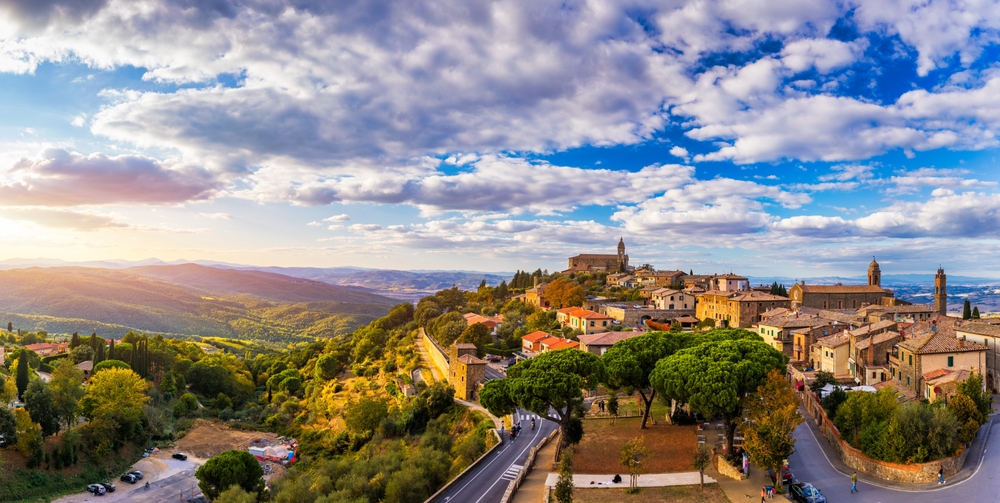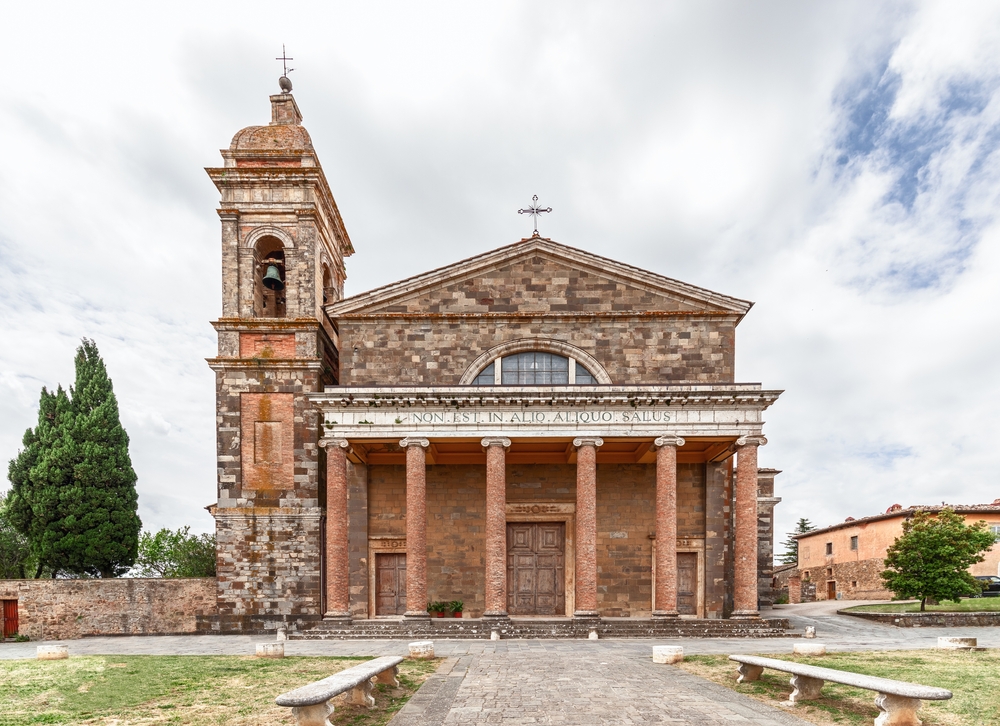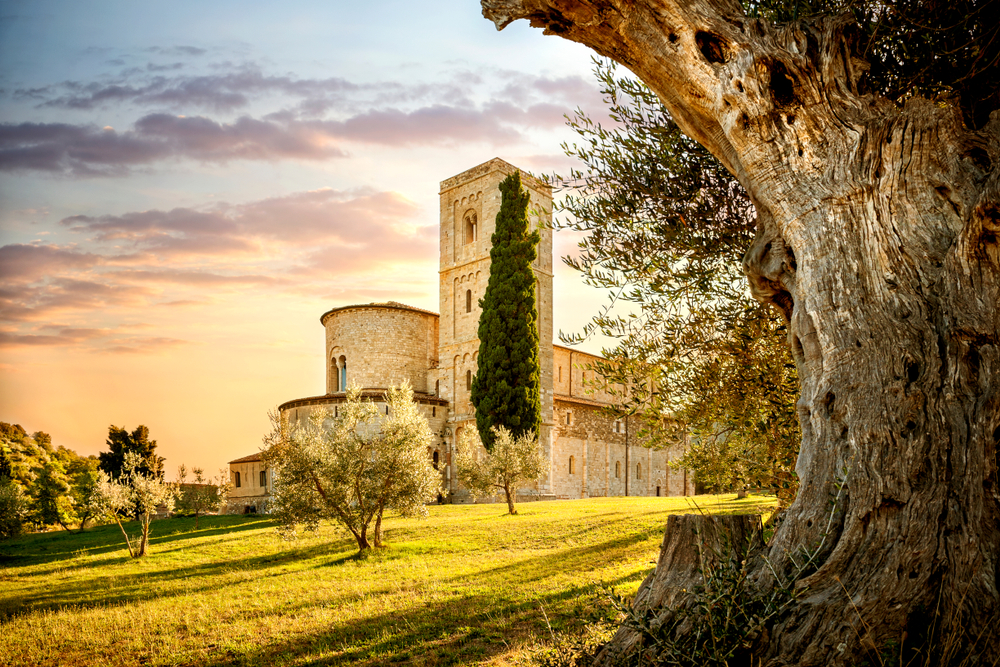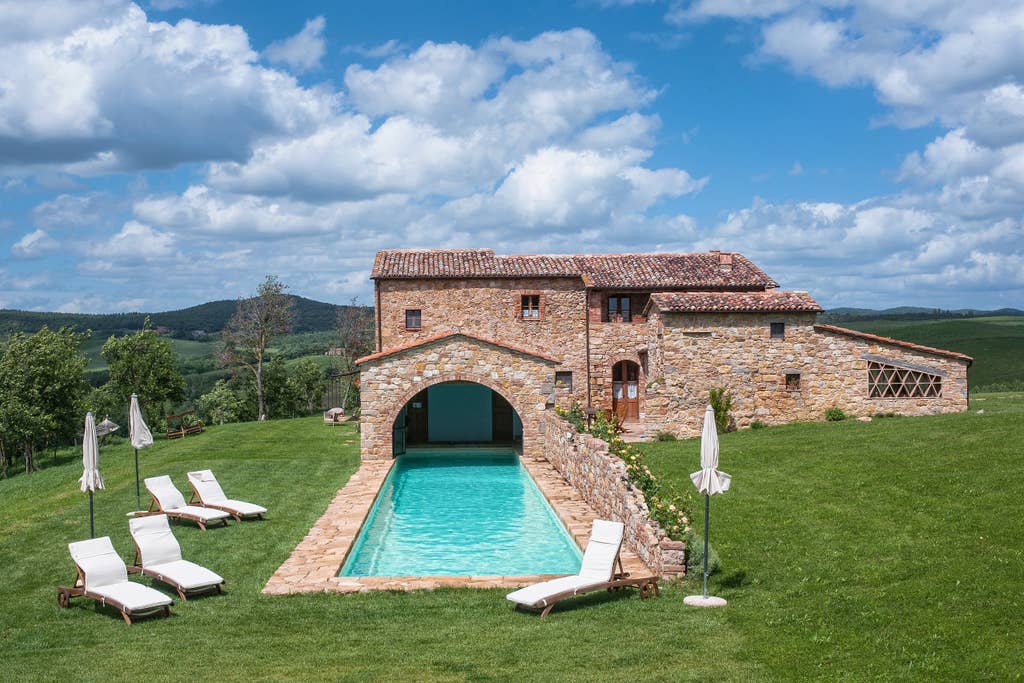Montalcino travel guide
Montalcino is a stunning hilltop town in the province of Siena in Tuscany. It takes its name from the expanse of oak trees that once covered the hillside and countryside around it. Since 2004, Montalcino and the valley that surrounds it has been recognised as one of Italy’s World Heritage sites.
Situated approximately 40 km south of Siena itself, it also lies a similar distance from Montepulciano to the east. Nestled in the heart of the Val d’Orcia National Park, the town has a long and fascinating history and has been inhabited since the Etruscan times. More recently, it has remained pretty much unchanged for centuries and a visit is very much a glimpse into how it would have looked in the 16th century.
The town is most famous throughout the world for its production of Brunello wine. The town has produced wine for centuries and already had an enviable reputation as a fine wine producer in the 15th century. But it is since the discovery of Brunello wine in 1888 thanks to Ferruccio Biondi Santi that it has risen to the fore of Italian wine making. Santi had the idea of omitting the grapes that had traditionally been used in Chianti wines such as Colorino and Canaiolo and instead using only the Sangiovese grapes. He then aged the wine for a minimum of 5 years (2 of which must be in oak barrels). It’s not the only wine the town is famous for though. The other wine the town is famous for is the Rosso of Montalcino. This differs from the widely regarded superior Brunello since this is ready after just one year of aging.
What to see and do in Montalcino
Montalcino’s 14th century fortress (rocca) dominates the town. Given its age, it’s in remarkable condition with most of its turrets and walls still standing. Once it would have served to protect the town from its enemoies. But these days it’s the frequent setting for a number of events held each year. But, even if you’re not visiting during one of these events, you should definitely not miss the opportunity to enjoy the spectacular views from its ramparts. Walk along the walls to make the most of the different views from each part of the structure. Inside its walls you’ll also find a wine shop – Enoteca La Fortezza.

A ticket to the fortress will also give you access to the Museo Civico e Dioceziano, where you can find an array of artefacts that bring the history of Montalcino to life. The museum is also home to a rich collection of paintings and sculptures from the Sienese school. If you enjoy time in museums, then Montalcino is also home to the Museo del Vetro (glass museum) where you can learn about the history of glass making starting from Egyptian times.
The other major landmark in the town is the 13th century clock tower in the Palazzo del Popolo, Montalcino’s main square. The long, slender tower on the Palazzo del Priore (also called the Palazzo Comunale) is not dissimilar to the Palazzo Vecchio in Siena. Nearby is the Loggia. This building dates back to the Renaissance period with six 15th century arches and is where you will find a great little restaurant – Alle Logge di Piazza. The square has a number of other cafes and restaurants where you can take a break and enjoy some people watching for a while.
Montalcino also has a number of churches worth visiting. The early 19th century Duomo (Cathedral of Santissimo Salvatore), dates to between 1818 and 1832. In fact, its origins date back much further. There was a building here in 1000 AD and this was declared a cathedral by Pope Pius II in the 15th century. But what exists today is very much a complete renovation from the 19th century. It sits in the higher part of the town and there are some terrific views to be enjoyed from the park outside.

Earlier Romanesque churches also well worth visiting in Montalcino include the Church of Sant’ Egidio, the Church of San Francesco and the Church of Sant’ Agostino. However, for us, one of the most beautiful churches in Montalcino is the Chiesa della Madonna del Soccorso. Step inside to admire the art works by both Francesco Vanni and Vincenzo di Benedetto di Chele Tamagni.
And we must not forget the 16th century Palazzo Pieri. This boasts a picturesque courtyard, home to an equally beautiful stone fountain. Rest your feet and enjoy a pit stop at the Circolo Arci cafe bar which you will also find here.
No visit to Montalcino would be complete without sampling some of its local wine in one of the many enoteca or at a nearby winery. There are some fantastic local Tuscany wine tasting tours to choose from at Get Your Guide. We can guarantee that this will end up being one of the highlights of your Tuscany trip.
And no visit would be complete without simply enjoying a stroll through its labyrinth of incredibly charming streets. Our favourites are the Via Spagni and the Via Giacomo Matteotti. Most streets are closed to traffic allowing you to meander your way around them, enjoying the plentiful displays of flowers that adorn the balconies above. As you explore, you’ll come across some charming little shops, wine bars, cafes and restaurants.
Last but not least, if you are visiting Montalcino, you may like to pay a visit to the nearby Abbey of Sant’Antimo.

This is situated approximately 8 km from Montalcino. It is a beautiful Romanesque church and monastery. Surrounded by the most incredible landscape, filled with olive groves, vineyards and rolling hills, it’s absolutely stunning. Pay a visit to the monastery pharmacy to pick up a homemade souvenir.
Events in Montalcino
Every Friday is market day in Montalcino. Held from 8 a.m. to 1 p.m., it’s the perfect place to buy regional specialities.
Montalcino’s fortress is used as the venue for a number of annual festivals and events. These include the annual Jazz & Wine Festival held each July. This event combines two of our favourite things – music and wine! During this event, Montalcino’s main square is also transformed into an open air music venue, where live music is performed whilst attendees can sit and listen whilst tucking into local delicacies.
Later in the year, on the last Sunday in October, the traditional Sagra del Tordo takes place. Residents dress up in historical costumes and re-enactments transport visitors back to Medieval times.
Where to stay in Montalcino
Casa Privata is a stunning traditional Montalcino villa. Situated just 20 minutes drive from Montalcino in the beautiful rolling hills of the Val d’Orcia, it’s an idyllic setting enjoying incredible 360 degree views.

Alternatively, opt for the nearby Villa Romantic, which definitely lives up to its name. It’s incredibly charming, in a similarly spectacular setting and with an interior that will immediately make you feel at home.
For those wishing to find a hotel in Montalcino, we’d recommend opting to find a great value Montalcino hotel on Expedia.
Alternatively, get in touch with the Bookings For You team to let them know exactly what you’re looking for and we’ll send through a range of villas in Tuscany to suit your needs.
How to get to Montalcino
By car: Montalcino is easy to reach by car and parking is readily available in a number of car parks outside the walls of the town. Some offer paid parking whilst others are free. If you need to hire a car, nearby Chiusi is probably the nearest place to do so.
By train: There is no train station in Montalcino. The nearest is in Buonconvento about 15 minutes away. From here, it’s a 30 minute bus ride to Montalcino. You will find that the bus timings generally run in sync with train arrival and departure times. Around 10 trains leave from Siena to Montalcino daily.
By air: The nearest airport to Montalcino is Perugia. This is just over 80 km away. Otherwise, Florence airport is only just slightly further (85 km) whilst Pisa is over 100 km away and Rome more than 150 km away.
By bus: The bus terminus in Montalcino is Piazza Cavour.


